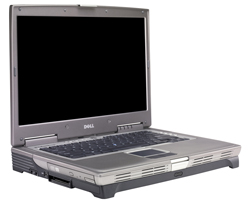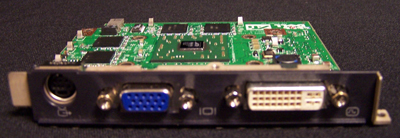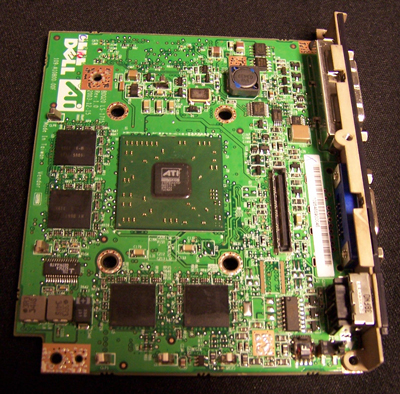Dell Inspiron XPS Preview - Power to Play and a bit more
by Andrew Ku on February 13, 2004 5:15 PM EST- Posted in
- Laptops
Today, Dell announces a notebook that marks their entrance into the enthusiast market (particularly if you know the code name). Dubbed the Dell Inspiron XPS, it is suppose to be the mobile version of the desktop Dimension XPS system.
The significance of this particular notebook is two fold. First, Dell has a much easier time to go after the enthusiasts in the mobile market over the desktop because overclocking is understood to be nonexistent. A Dimension XPS system, meanwhile, provides limited options for the enthusiast that could just as well built one from the ground up with a wider range of performance enhancing options (RAID, overclocking, etc...). Considering the branding behind the Dell name and the expectations behind an enthusiast notebook, the Dell Inspiron XPS already has a good head on its shoulders. This will likely to appeal even to the general prospective desktop replacement owner.
The Dell Inspiron XPS (far right is a picture with a clip-on backpanel - Plasma design)
Secondly, Dell is also warming up to the concept of upgradeable notebooks (only sought out by Alienware thus far); the most obvious step being in the system's GPU configuration. With the Inspiron XPS system, Dell is starting to standardize their modular graphics format, which means that Inspiron XPS owners down the road can upgrade their graphics card. Keep in mind that modular graphic formats aren't the same among the different system vendors and even between model lines of a single system vendor.
Upgradeable graphics isn't a new thing for Dell, as this was possible with the Inspiron 8600, but technically those were "black-market" cards that you were swapping in and out, since Dell wasn't publicly providing the upgrade option. *Though, some of you readers have told us that you managed to upgrade through Dell's spare parts ordering service.*
The problem with upgradeable graphics also comes down to be a support issue. The last thing Dell wants is a misinformed user purchasing a new mobile graphics card and sending back the entire system because they weren't satisfied with performance. In order to avoid the onslaught of RMAs, technical support calls, etc..., Dell is providing the option of upgrading graphics through them only. Basically, a Dell support guy will come out to your house (you can also go into one of their support stores I believe) and will swap out the old card and install the new drivers and everything to make sure everything is copasetic.
The form factor of the modular graphic card in the Inspiron XPS system is fairly simple. The top side of the XPS graphic module is home to the discrete mobile GPU, while the edge of the card is home to the s-video, DVI-I, and VGA ports. These are visible from the back side of the system, seen in the picture above. In a sense, it is similar to a PCI type design. Traditionally, modular graphic cards on notebooks interfaced with the motherboard and the system's VGA port was accomplished via additional PC traces. Obviously, the first iteration of the Inspiron XPS system will come with the Mobility Radeon 9700. The fact that Dell is going to allow for upgradeable graphics tells us that the Inspiron XPS system or its graphic's form factor will have a fairly long life cycle.
We won't bore you with the details you can get from the press release, but we already have a very good impression of the system (despite it weighing in at 9 pounds), particularly already having kind of tested out the waters with a beta system. The beta system we tinkered around with used a 2.8GHz Prescott, which we aren't even sure is from a final silicon batch. It doesn't really matter since it doesn't look like it will be shipping at this speed. For this reason, the benchmarks from this system are more or less moot, but we will get around to benchies soon...
Basically, it looks like an Inspiron 8600 on an elevated platform. The 15.4" WUXGA screen we saw on the beta system was stunning and more brilliant than the 8600, which quite frankly was already a great system to begin with... We have high expectations, so stay tuned.
Btw, you can thank the boys and girls at Dell for the nice high res shots that they whipped up just for you guys, otherwise this would be 100% text...














14 Comments
View All Comments
thbde - Monday, March 1, 2004 - link
Well, alright, it might be heavy and hot. However, I ordered one (though not the EE) for one reason: to use it as a 'mobile' workstation. The fast desktop CPU and a system board supporting 400 MHz, 1 GB of RAM, allows for serious software development. One can run a Database server next to a WebSphere Exclipse Application Studio development environment.A mobile CPU is simply not up to the task.
stephenvv - Tuesday, February 17, 2004 - link
I think the uber laptop category is overrated. People think the don't want portability but why are you buying a notebook? If you need a bigger screen, keyboard etc. just get a external monitor, keyboard etc. I think they are like SUV's, big, fat, ungainly and sucking up energy.I recently bought a notebook and look at nearly every model out there. I considered everything from ultralight to luggables.
I needed it for everything - work (Adobe Creative Suite, Project, MS Office 2003), art (After Effects, 3D, Vegas+DVD) and play (mostly EA Sports titles). Plus I wanted take it out of the house 3-4 times a week and run on battery for at least 2 hours.
Solution? Despite not being an IBM fan and wishing Thinkpads looked cooler, I'm bought a t41p. Sure, this Dell (or insert huge Alienware, Sager) beast might be a few percentage points faster, but at what cost is weight, price, durability and practicality?
P4-M at 1.7, 1 GB RAM, 60 GB 7200 RPM, ATI Mobility Fire GL T2 w/ 128 MB driving a fantastic SXVGA LCD. $3150 delivered. Oh, and it's 5.5 lbs and comes with Gigabit Ethernet and a/b/g wireless with a great antenna design that doubled my signal strengh over my g PCcard and boosted ranged by 20%. Plus the drive shock protection etc. etc.
After 6 weeks, I love it. 5 hours of battery life, fast as a desktop. Only quibbles are FN/CTRL key placement and tinny speakers. But then what notebook has great speakers...
This is the best notebook I have ever touched. If you need larger screen, the t50p is available.
So if you are considering a "desktop replacement", you might want to think again as I did. Even if your computer never leaves the house, I carry this one all over, including sitting outside. The difference between 5.5 and 10+ lbs, between 5 hours battery life and 45 minutes is a big deal.
I fail to see what real advantage a machine like this offers. You can get 7200 rpm disks, fast CPU, fast memory, fast GPU's without building a brick. All this gets you is some very weak bragging rights.
Ecmaster76 - Monday, February 16, 2004 - link
...Or just make a cube SFF PC with a folding LCD and keyboard.plewis00 - Sunday, February 15, 2004 - link
Frankly I applaud Dell for taking this step. Dell are perhaps one of the market leaders in top-spec/high-end notebooks (I wouldn't trust their ultraportables as much as an IBM or Sony) and this is simply evolution. Dell were the first (and only) to implement the GeForce 4 Go 4200 (based on the GF4 Ti architecture) which is still a formidable mobile card (ok, it's power consumption was bad) and beats out the GeForce FX Go 5650 in DX8.1 benchmarks. If you don't like it though, then don't buy it. But if you do like to transport your machine to friends' houses for gaming/watching films, this is a godsend. I suspect Dell won't charge stupid premiums for it either since it is based around their current notebooks (so no major redesigns) and Dell are normally quite good about this kind of thing.One thing does spring to mind though is rather than kitting out these machines with desktop CPUs and mobile GPUs, why not either kit the thing out completely with desktop parts (and scrap a battery - perhaps a WD Raptor 74Gb hard disk could go in it then) or exchange the parts for a mobile CPU and a desktop GPU (i.e. shifting the cooling capacity there instead) as I could bet a Radeon 9800 Pro with a P4-M at 2.6Ghz would slaughter a P4 3.4Ghz (800Mhz FSB) with a Mobility Radeon 9700. Power is not an issue (if your going to run off mains - perhaps you could have a small battery for standby modes and moving the machine small distances?), since Shuttle have very good small power supplies you could squeeze one of those 250W supply somewhere I'd think. Anyone else wondered this ever perhaps?
Pumpkinierre - Sunday, February 15, 2004 - link
What does 'copasetic' mean? Sounds Silicon Valley!Geekish Thoughts - Saturday, February 14, 2004 - link
It was only a matter of time before Dell realized that companies like Sager (via www.powernotebooks.com) and the like were making some bucks from these uber laptops. For me? No. But for the mobile gamer who has a ton of cash... yes. Dell wants to make money off everything.daniel1113 - Saturday, February 14, 2004 - link
According to Dell, it is 9 punds, not 14...PrinceGaz - Saturday, February 14, 2004 - link
It'll be interesting to see (or feel) how hot these Prescott based laptops actually run. Unless the mobile Prescott uses far less power than the desktop version I fail to see how it can be a viable option.Serp86 - Saturday, February 14, 2004 - link
How the hell can you cool a 3.4ghz prescott in a laptop when a desktop already can barely keep up with a 3.2ghz one? Bet the fan brings flashbacks of the fx5800ultra.CrystalBay - Friday, February 13, 2004 - link
Well it's a start... I wont say anything A64M, oops, point me somewhere around 2k with a M11 or M10pro and I'll go...